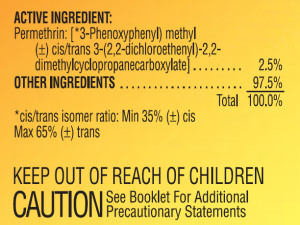Pyrethroid insecticides are a special chemical class of active ingredients found in many of the modern insecticides found on store shelves and used by pest management professionals. The name pyrethroid means “pyrethrum-like” and refers to the origin of this class of pesticides.
Characteristics of pyrethroids
Not all pesticides in the same class are equally toxic, or equally effective the same pests. Nevertheless, most pyrethroid insecticides share the following characteristics:
- Low in toxicity to mammals and birds;
- High in toxicity to fish if applied directly to water;
- Require very low doses to kill insects (high arthropod toxicity);
- Fast-acting;
- Especially effective against chewing insects, though many pyrethroid insecticides can be absorbed by the insect pest when it merely walks over the dry residue;
- Bind tightly to soil and organic matter (therefore not as effective in penetrating soil to kill underground pests);
- Dissolve very poorly in water.
Pyrethroids became popular as consumer insecticides in the 1990s as replacements for older pesticides, like diazinon and Dursban® that were phased out for environmental and human health reasons. Some pyrethroid insecticides last a long time in the environment (days or weeks), especially when protected from sunlight. Others, such as allethrin and resmethrin, break down within a few minutes to a few hours after application.
Recognizing pyrethroid insecticides

A typical insecticide label includes both common and chemical names for the active ingredients. The common name of the active ingredient in this product is permethrin.
It’s not too difficult to recognize a pyrethroid insecticide. Look at the pesticide label, generally on the front of the product, and look for the list of active ingredients. Active ingredients usually list a chemical and a common name. The chemical name is generally long and contains a mixture of terms, parentheses and numbers that describe the actual molecular structure. The common name is a shorter name that is assigned to the pesticide, because chemical names are too long and complicated even for chemists to remember. The common name may or may not be part of the pesticide’s trade name–which is the big name you first see when you look at a product on the shelf, or hear in advertisements.
Pyrethroid common names almost always end in either -thrin or -ate. Examples include allethrin, resmethrin, permethrin, cyfluthrin or esfenvalerate. Notice the common suffixes -thrin and -ate? The only tricky thing to remember is that the common name pyrethrins (note the plural form) still refers to the original plant-derived mixture from the chysanthemum flowers. Many organic gardeners accept the use of pyrethrins on their crops because this product is organically derived, but there is nothing natural about pyrethroid insecticides. If you wish to garden organically, don’t confuse pyrethroids with pyrethins (or the older term, pyrethrum).
History of Pyrethroids
The term pyrethroid is confusing to many because of its similarity to the name of the natural insecticide mixture known as pyrethrum or pyrethrins. Pyrethrum is one of the oldest known insecticides and comes from the dried and crushed flowerheads of two species of asters: Chrysanthemum cinerariifolium and C. coccineum.
Purified pyrethrum, called pyrethrins, has been very useful in insect control. It kills a variety of insects and mites, knocking them off plants very quickly. For this reason, and because of its relatively low toxicity to people, pyrethrins remain very popular today (think of Raid® Flying Insect Killer, and many others). Pyrethrins also have the desirable environmental characteristic that they break down quickly (minutes to hours) in the outdoor environment (from a pest control perspective, this may not be an advantage).
Unfortunately for farmers, pyrethrum has always been expensive, and natural supplies are limited and often unreliable. For this reason, pesticide chemists after WWII considered it a high priority to search for ways to synthesize pyrethrins in the lab. The result, in 1949, was the first artificial pyrethrin-like insecticide called allethrin.
Once chemists figured out the techniques for synthesizing this class of insecticide, many different versions were created. In the 1960s a number of new, “second-generation” pyrethroids were patented, including tetramethrin, resmethrin, bioallethrin and phenothrin. These new compounds were many times as toxic to insects as natural pyrethrum and still have many uses today, including household insecticides. Since the 1960s, further advances in synthesis have created new, useful insecticides that resemble the original pyrethrin molecules less and less. These new pyrethroid insecticides have become more toxic to insects and last longer in the environment than the early compounds.